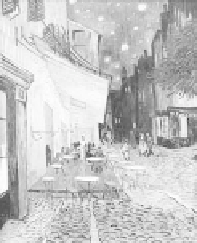Travel Reference
In-Depth Information
some
Sunflowers,
and
Café de Nuit,
the famous
scene of an al fresco café on a f loodlit Arles
square. Notice how thickly the paint is caked
on to create the almost 3-D lamp, the work's
focal point.
Eating at Kröller-Müller Museum:
Consider the self-service restaurant Monsieur
Jacques (€4 soups and sandwiches, €9 salads,
Tue-Sun 10:00-16:30, closed Mon).
After visiting the museum, grab a free
white bike for the three-quarter-mile pedal to
the national park's Visitors Center, described below.
mOrE SIGhTS
ss
Hoge Veluwe National Park (Nationaal
Park de Hoge Veluwe)
The Netherlands' biggest national park is a delight to explore. On a
quick visit, a short pedal and a visit to the Kröller-Müller Museum
are enough; with more time, also swing by the Visitors Center and
bike to your heart's content. The hunting lodge (described on next
page) makes a fun destination. If you head deeper into the park,
you'll find a surprising diversity of terrain, from inland sand dunes
to lakes to moorland. Get advice, maps, and brochures at the park
entrances or at the Visitors Center.
Cost, Hours, Information:
Entry to the park costs €7; a €14
combo-ticket includes the Kröller-Müller Museum. The park is
open daily June-July 8:00-22:00, May and Aug 8:00-21:00, April
8:00-20:00, Sept 9:00-20:00, Oct 9:00-19:00, Nov-March 9:00-
18:00, last entry one hour before closing (park tel. 055/378-8100,
www.hogeveluwe.nl).
Visitors Center (Bezoekerscentrum)
—This fine center is a
good place to get your bearings in the park, with a helpful infor-
mation desk, nature exhibit, WCs, playground, restaurant, and
hub for free loaner bikes (daily April-Oct 9:30-18:00, Nov-March
9:30-17:00, park tel. 055/378-8100, www.hogeveluwe.nl). Browse
the collection of brochures and maps, including the good €2.50
map of the park, and the €1 self-guided bike tour, with commen-
tary on the main stops.
he
nature exhibit
features interactive, kid-oriented exhib-
its, well-explained in English. It's divided into two parts: An
above-ground section focuses on the parks' various landscapes
and the animals that live above ground; then you'll go through a
tunnel to reach the second section, called the “Museonder,” which
shows life underground (animals, fossils, the water table), with
conservation-themed displays. Ask for an English showing of the




















